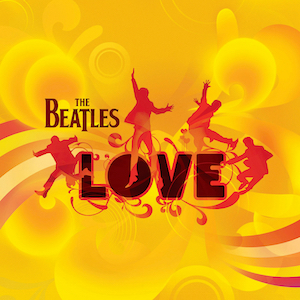
Love (2006)

1. Because
2. Get Back
3. Glass Onion
4. Eleanor Rigby/Julia
5. I Am the Walrus
6. I Want To Hold Your Hand
7. Drive My Car/What You're Doing
8. Gnik Nus
9. Something/Blue Jay Way
10.Being For the Benefit of Mr.Kite/
I Want You (She's So Heavy)/Helter Skelter
11.Help!
12.Blackbird/Yesterday
13.Strawberry Fields Forever
14.Within You Without You/Tomorrow Never Knows
15.Lucy in the Sky With Diamonds
16.Octopus's Garden
17.Lady Madonna
18.Here Comes the Sun/The Inner Light
19.Come Together/Dear Prudence/Cry Baby Cry
20.Revolution
21.Back in the U.S.S.R.
22.While My Guitar Gently Weeps
23.A Day in the Life
24.Hey Jude
25.Sergeant Pepper's Lonely Heart's Club Band (Reprise)
26.All You Need is Love
Spotify and I-Tunes Bonus Tracks
27.The Fool on the Hill
28.Girl
By the mid-2000s, it was generally accepted that The Beatles' vaults had been thoroughly explored. The Anthology series had already served as a near-definitive excavation of outtakes, demos, and session fragments. Thus, when Love appeared—accompanying a Cirque du Soleil production in Las Vegas—it raised eyebrows. This was not an archival release in the traditional sense, nor a greatest hits compilation. Instead, it presented a curated reimagining: part mashup, part homage, executed under the direction of George Martin and his son Giles.
Love is a collage. Rather than remixing individual tracks, the Martins reconstructed them. Familiar pieces were deconstructed and rearranged, drawn together with a kind of theatrical logic intended to match the narrative arc of the stage production. The result is not a new Beatles album, but rather a re-contextualized one—music that is already deeply embedded in cultural memory, offered in altered sequence, juxtaposition, and occasionally, in altered form.
One of the more memorable moments on the album is an alternate version of While My Guitar Gently Weeps, a delicate orchestral rendition previously unreleased. Its inclusion lends a fragile and meditative quality that contrasts sharply with its original, making clear that the project is not simply a technical exercise, but one with emotional and aesthetic stakes. Elsewhere, familiar transitions are reimagined. The opening of Because segues unexpectedly into fragments of A Day in the Life; the effect is less surprising than it is strangely inevitable, as if the songs had always implied one another.
Nevertheless, the album's success is uneven. For every inspired combination, there are selections that remain virtually untouched, such as Get Back, whose presence feels perfunctory. These conservative moments disrupt the overall cohesion and suggest limitations—whether technical, conceptual, or theatrical—in the project's scope. The inconsistency is notable: when the album leans into its premise, it reveals the elasticity of The Beatles' music; when it retreats, it feels like padding.
Ultimately, Love is unlikely to serve as an entry point for new listeners. It presupposes a high level of familiarity with the band’s catalogue, and derives its value chiefly from recontextualization. The thrill lies in recognition, in noticing a drum fill from one song resurfacing beneath the guitar riff of another. As such, it is best suited to long-standing admirers—those willing to entertain an alternate history of the band, one where chronology dissolves and tracks converse across albums.
As a standalone listening experience, Love may lack the narrative clarity or emotional arc of the band’s canonical albums. But it accomplishes something else. It affirms that the Beatles’ work—now over half a century old—remains pliable, surprising, and capable of reinvention. The novelty may fade with repeated listens, but the craftsmanship endures. This is not a definitive statement on their legacy, but a compelling footnote—one shaped by reverence, risk, and, above all, an enduring sense of play.
Go back to the main page
Go to the Next Review